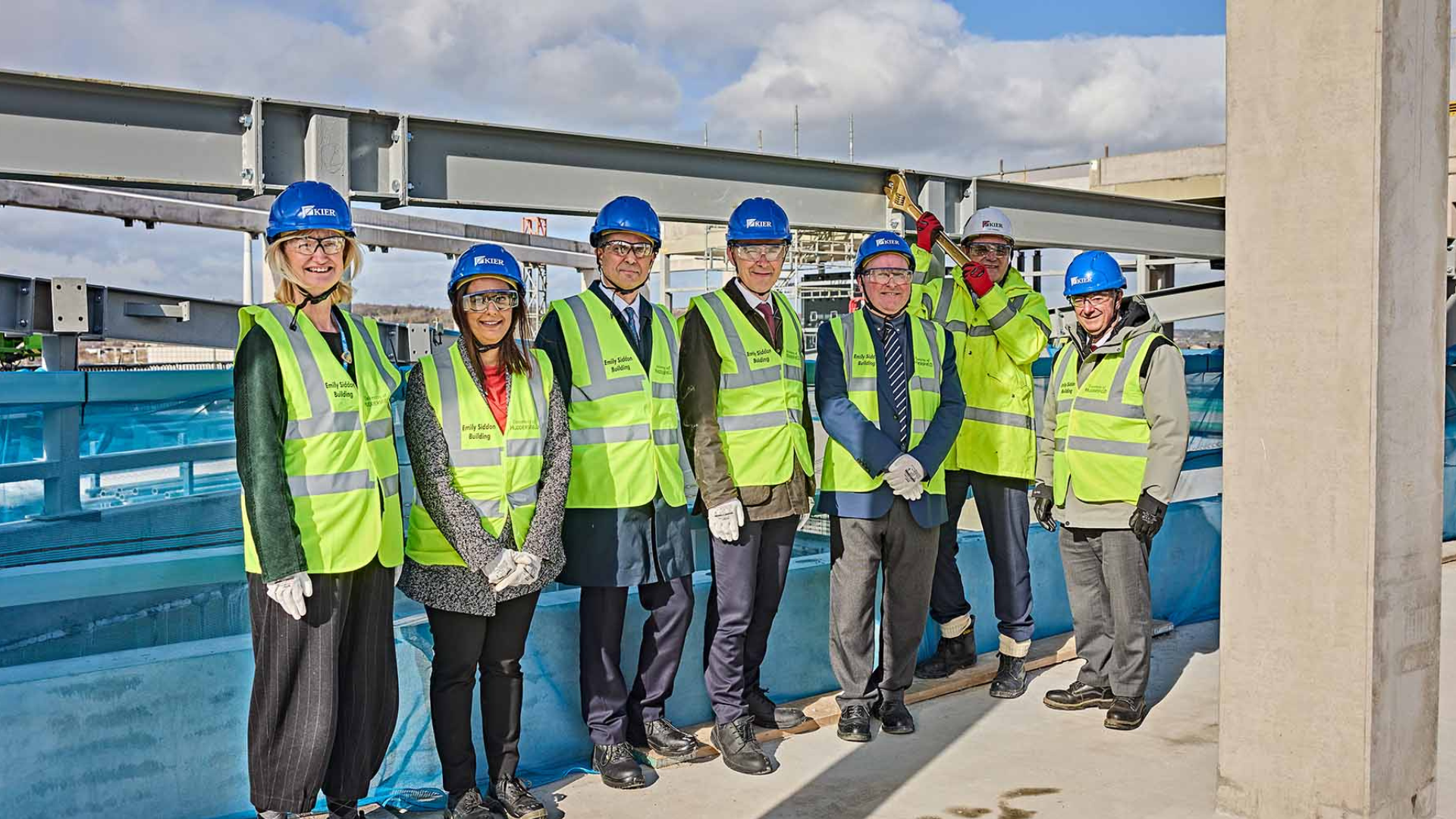On Friday, 28th March, the development of the University of Huddersfield’s National Health Innovation Campus (NHIC) reached a significant stage with a topping out ceremony for the Emily Siddon Building, which will be the location for our new Huddersfield Community Diagnostic Centre (CDC). The bolt-tightening ceremony, marked the completion of the highest point on the new building.
The 6,800m² facility, expected to open in January 2026, will host new purpose-built diagnostic facilities including MRI and CT scanners. The CDC will be the first on a UK university campus and will provide care closer to home with access to thousands of additional diagnostic tests, including MRI and CT scans.
Catherine Riley, Associate Director of Strategy, CHFT, attended the ceremony along with other guests which included, University of Huddersfield Vice-Chancellor Professor Bob Cryan CBE, Professor Mark Radford, Deputy Chief Nursing Officer for NHS England, Huddersfield MP Harpreet Uppal, Daniel Doherty, Regional Director of Kier Construction, Rob Hopkins, Director of architects AHR and Russell Green, Project Manager of construction consultants Gleeds.
Catherine said: “The new Community Diagnostic Centre will bring diagnostic services closer to our communities, making sure people have timely access for tests such as X-Rays, CT scans and MRI’s all in a convenient location. Being in the centre of Huddersfield means that we can give greater choice to our patients and increase the number of tests we carry out and means that some people don’t even need to come to hospital at all.
“We’re already seeing fantastic outcomes for our patients at our CDC in Halifax which completes around 1,500 tests a week and has received wonderful feedback.”
Professor Cryan said: “It will be very exciting to see this building evolve over the next few months, with the promise that we will soon see and use a facility that is going to add so much to the University, but will also help to make a real difference to health outcomes in the local community as well."
Professor Radford added, “Whilst this feels like a building, it is so much more than that. It takes civic responsibility beyond investment and into intervening in communities and providing health and wellbeing services for the community around here. This requires vision and a team to think ahead, understanding what the town, health and education needs, and it takes real guts as well as money to make those changes.”
Other floors of the building, designed by architects AHR, will contain specialist clinical teaching facilities which will also be delivered in partnership with the Trust, including new course areas relating to the work of the CDC, such as Diagnostic Radiography. Work with other partners will allow for further developments, including Dental Hygiene and Dental Therapy BSc which will begin September 2025.
With 280m² of photovoltaic panels, the building has been designed to meet BREEAM ‘Excellent’ standards, ensuring the facility is environmentally sustainable. Additionally, the design aims to achieve the same WELL Platinum certification as the University's Jo Cox More In Common Centre for its design and operational strategies focusing on human health and well-being.
It is the second NHIC building and is adjacent to the Daphne Steele Building, which opened in September 2024 on Southgate in Huddersfield town centre close to the university’s main campus.
The building is named after the healthcare advocate and governor of Huddersfield Technical College, a forerunner of the University, who spent the majority of her life in nearby Honley.
The CDC at Huddersfield is part of the Foundations for our Future programme, which is our long-term plan to transform our hospital and community services in Calderdale and Huddersfield.
About Emily Siddon
A leading healthcare advocate who spent most of her life in nearby Honley, Emily Siddon strove to improve healthcare and equality in several prestigious roles, often reserved for men.
An advocate for improving children’s health, Emily was also involved in the creation of children’s homes with better conditions than the workhouse.
Emily’s many influential roles included being one of the first women to be a Poor Law Guardian in 1883, at a time when the role was vital in provided health and welfare support to disadvantages communities. She went on to be Vice Chair of the local Board of Guardians in 1903 and its Chair in 1913. As a highly respected member community,
Emily was heavily involved in driving healthcare and equality developments in the Huddersfield area, including being a member of the Huddersfield Female Educational Institute from 1868 and a governor of Huddersfield Technical College from 1907 – both organisations being forerunners of the current University - until her death in 1923. Late in her life she had become only the second woman in the country to be made a Justice of the Peace and had a particular focus on mental health and learning disabilities.
Huddersfield Technical College was recognised by the Pharmaceutical Society of Great Britain’s list of approved institutions during Emily’s time as governor, and it also pioneered equal pay and pensions. Emily was also appointed as the only female member of the main executive committee at the Huddersfield Infirmary from the late 19th century into the 20th century.
A passionate supporter of the campaign for women to have the right to vote, Emily was Vice-President of the Council of the National Union of Women’s Suffrage Societies from 1907.


